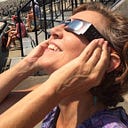
Member-only story
The Value of Color
Art’s Real Worth as a Meta Collectivist Perspective
I have always loved color. With no other perspective than my own, I’ve no idea, for example, how many people in this world would be out-of-their-minds happy to sit down with a Pantone color book for two hours, sipping coffee as sunshine streams through a picture window bouncing light onto each page.
That’s literally where I was a year ago at my cousin’s house in Indiana. Kelly O’Dell Stanley is an artist, as was her father, my uncle. As I remember, she was at church that morning, and so was I.
Whether this particular two-hour communion with color in her dining room led me to pick up my first brush and buy a small watercolor kit after Covid-19 hit, I don’t know. It doesn’t matter.
What seems to matter is that I’d been telling myself a lie. That I was no good at art. That I could write, that I could play the piano (so-so) and the flute and that long ago I could sing. That was the extent of my artistic capabilities as I understood them. Because that was all I accepted about myself.

But this acceptance was simply an uninformed lie. I’d never tried anything visual arts-wise. I had settled into what Carol Dweck calls a fixed versus growth mindset. One that maintained rather rigid assumptions about my abilities. Ironically, I’d been teaching Dweck’s work for years but I hadn’t seen that I had a fixed notion of my creative capabilities — before even attempting them.
Except, there was that one collage I’d made in a fit of manic anger. I’d kept it among some old posters, now living under my bed like a little ghost of Christmas past. Christmas Eve 2003, my then-husband told me he was leaving me and the children in the morning. (He did.) But it didn’t seem like real art.

This year, while sheltering in place, I decided to give collaging another go. I’d found an old letter written by a girl I’d sung with in several high school…
